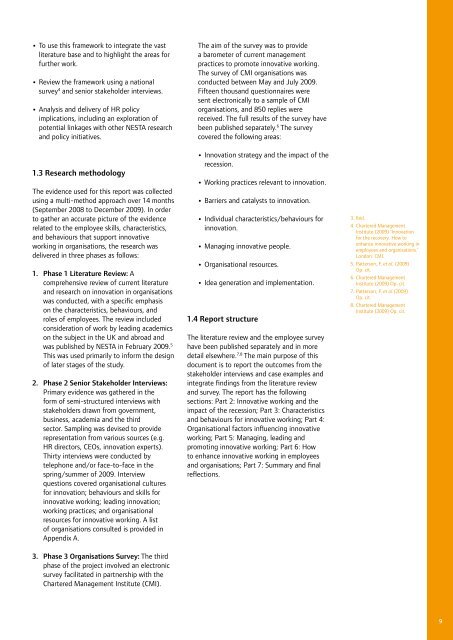Everyday innovation report - Nesta
Everyday innovation report - Nesta
Everyday innovation report - Nesta
Create successful ePaper yourself
Turn your PDF publications into a flip-book with our unique Google optimized e-Paper software.
• To use this framework to integrate the vast<br />
literature base and to highlight the areas for<br />
further work.<br />
• Review the framework using a national<br />
survey 4 and senior stakeholder interviews.<br />
• Analysis and delivery of HR policy<br />
implications, including an exploration of<br />
potential linkages with other NESTA research<br />
and policy initiatives.<br />
1.3 Research methodology<br />
The evidence used for this <strong>report</strong> was collected<br />
using a multi-method approach over 14 months<br />
(September 2008 to December 2009). In order<br />
to gather an accurate picture of the evidence<br />
related to the employee skills, characteristics,<br />
and behaviours that support innovative<br />
working in organisations, the research was<br />
delivered in three phases as follows:<br />
1. Phase 1 Literature Review: A<br />
comprehensive review of current literature<br />
and research on <strong>innovation</strong> in organisations<br />
was conducted, with a specific emphasis<br />
on the characteristics, behaviours, and<br />
roles of employees. The review included<br />
consideration of work by leading academics<br />
on the subject in the UK and abroad and<br />
was published by NESTA in February 2009. 5<br />
This was used primarily to inform the design<br />
of later stages of the study.<br />
2. Phase 2 Senior Stakeholder Interviews:<br />
Primary evidence was gathered in the<br />
form of semi-structured interviews with<br />
stakeholders drawn from government,<br />
business, academia and the third<br />
sector. Sampling was devised to provide<br />
representation from various sources (e.g.<br />
HR directors, CEOs, <strong>innovation</strong> experts).<br />
Thirty interviews were conducted by<br />
telephone and/or face-to-face in the<br />
spring/summer of 2009. Interview<br />
questions covered organisational cultures<br />
for <strong>innovation</strong>; behaviours and skills for<br />
innovative working; leading <strong>innovation</strong>;<br />
working practices; and organisational<br />
resources for innovative working. A list<br />
of organisations consulted is provided in<br />
Appendix A.<br />
3. Phase 3 Organisations Survey: The third<br />
phase of the project involved an electronic<br />
survey facilitated in partnership with the<br />
Chartered Management Institute (CMI).<br />
The aim of the survey was to provide<br />
a barometer of current management<br />
practices to promote innovative working.<br />
The survey of CMI organisations was<br />
conducted between May and July 2009.<br />
Fifteen thousand questionnaires were<br />
sent electronically to a sample of CMI<br />
organisations, and 850 replies were<br />
received. The full results of the survey have<br />
been published separately. 6 The survey<br />
covered the following areas:<br />
• Innovation strategy and the impact of the<br />
recession.<br />
• Working practices relevant to <strong>innovation</strong>.<br />
• Barriers and catalysts to <strong>innovation</strong>.<br />
• Individual characteristics/behaviours for<br />
<strong>innovation</strong>.<br />
• Managing innovative people.<br />
• Organisational resources.<br />
• Idea generation and implementation.<br />
1.4 Report structure<br />
The literature review and the employee survey<br />
have been published separately and in more<br />
detail elsewhere. 7,8 The main purpose of this<br />
document is to <strong>report</strong> the outcomes from the<br />
stakeholder interviews and case examples and<br />
integrate findings from the literature review<br />
and survey. The <strong>report</strong> has the following<br />
sections: Part 2: Innovative working and the<br />
impact of the recession; Part 3: Characteristics<br />
and behaviours for innovative working; Part 4:<br />
Organisational factors influencing innovative<br />
working; Part 5: Managing, leading and<br />
promoting innovative working; Part 6: How<br />
to enhance innovative working in employees<br />
and organisations; Part 7: Summary and final<br />
reflections.<br />
3. Ibid.<br />
4. Chartered Management<br />
Institute (2009) ‘Innovation<br />
for the recovery: How to<br />
enhance innovative working in<br />
employees and organisations.’<br />
London: CMI.<br />
5. Patterson, F. et al. (2009)<br />
Op. cit.<br />
6. Chartered Management<br />
Institute (2009) Op. cit.<br />
7. Patterson, F. et al (2009)<br />
Op. cit.<br />
8. Chartered Management<br />
Institute (2009) Op. cit.<br />
9







